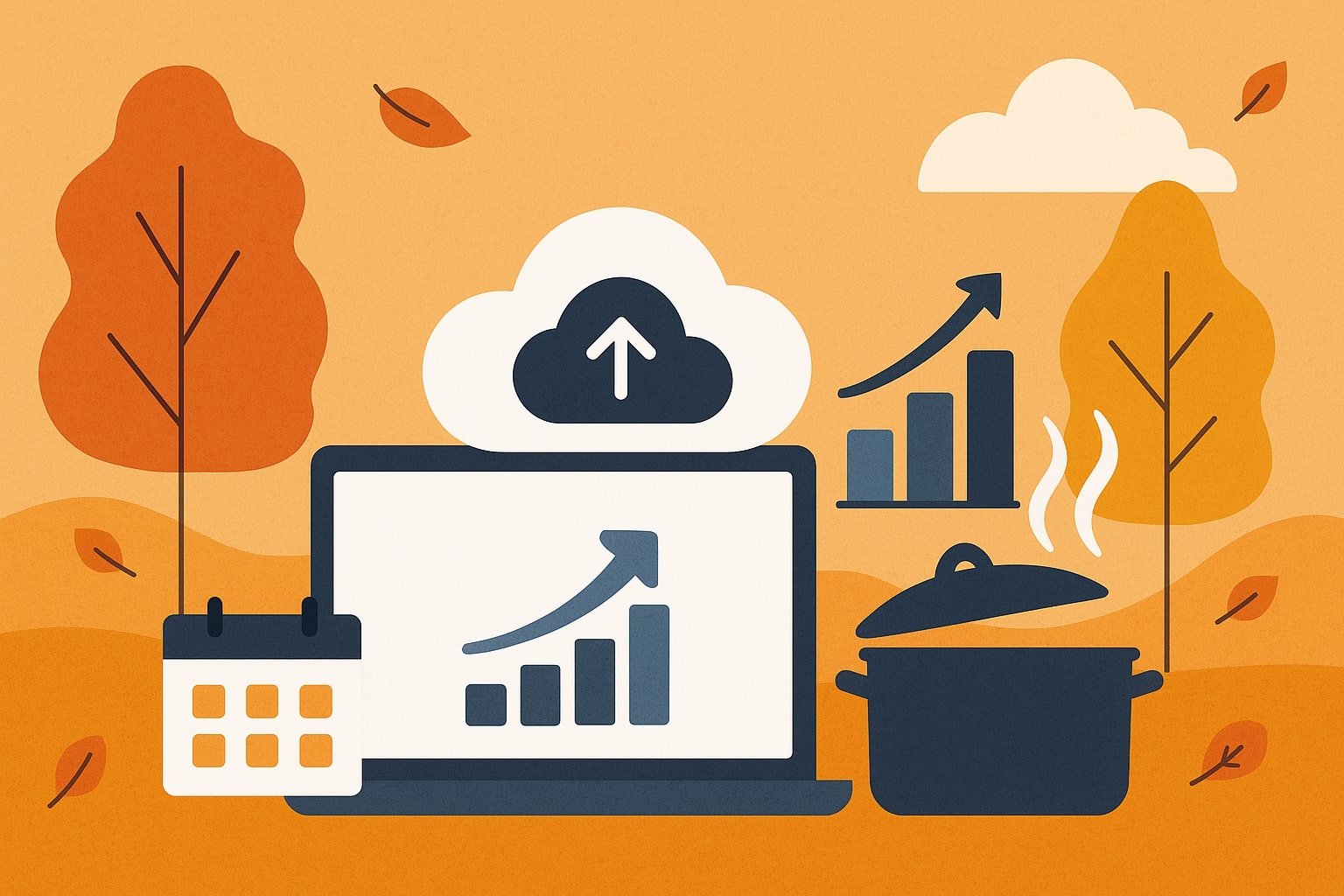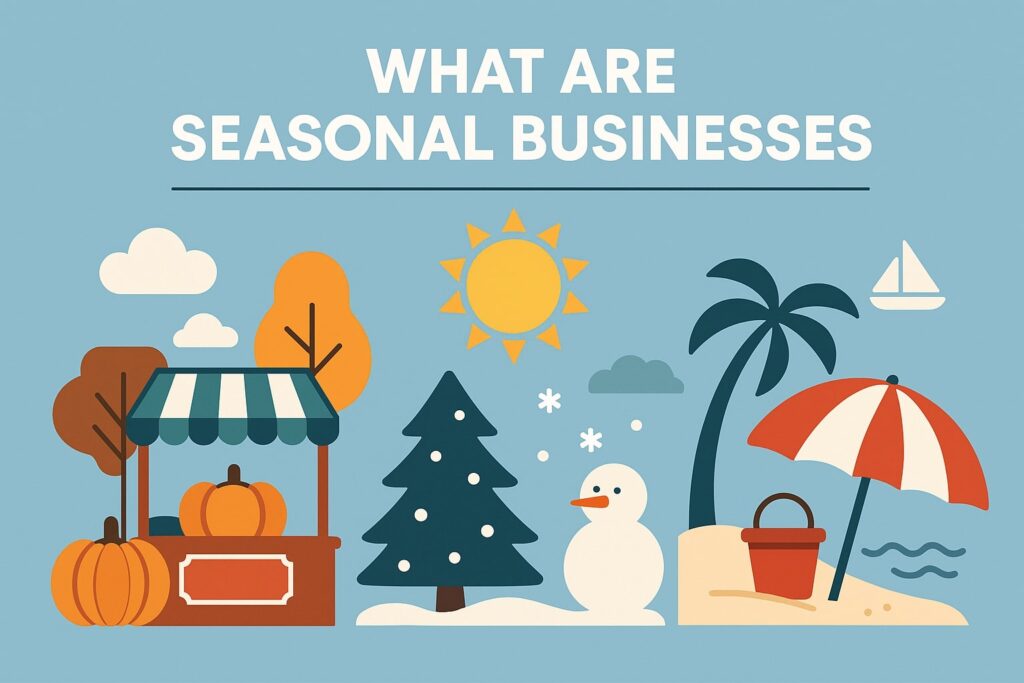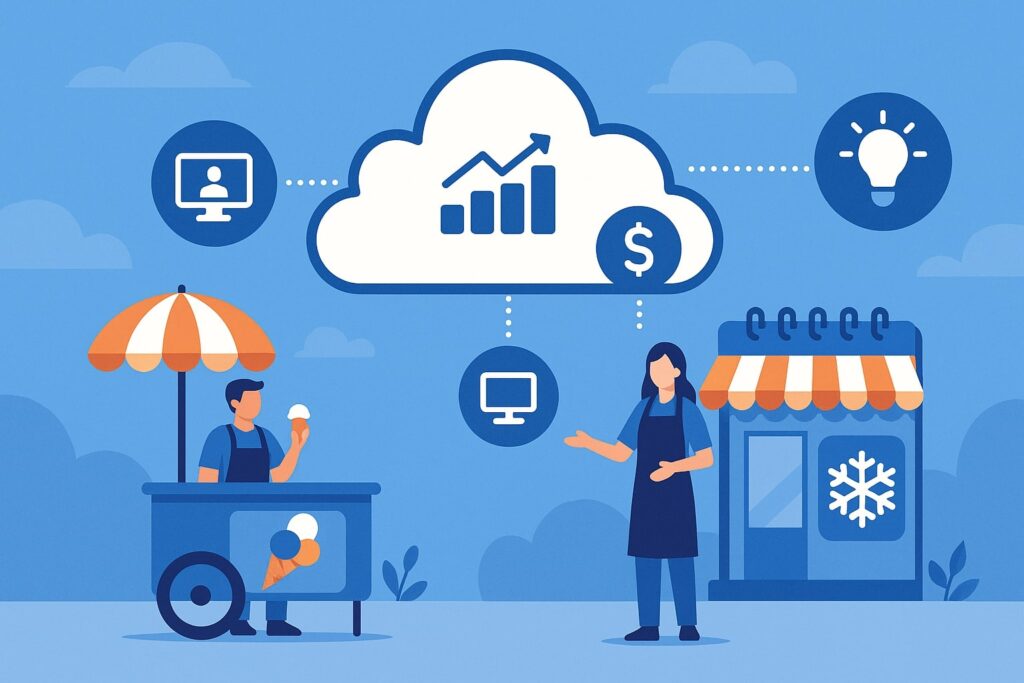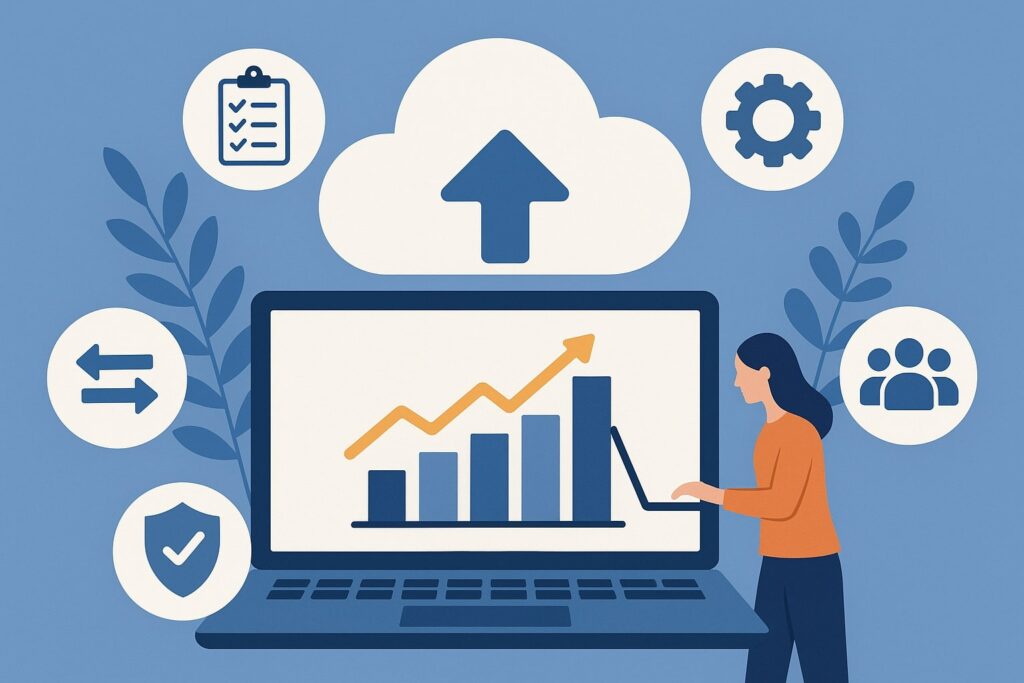
By cloudcateringmanager September 23, 2025
Seasonal businesses—such as tourism, hospitality, retail during holidays, and landscaping—earn the bulk of their revenue during limited peak periods each year. In the United States alone, millions of firms rely on the busy season to sustain operations year-round.
For example, the U.S. Department of Labor notes that roughly 7.3 million establishments employ about 135 million workers across seasonal or part-time roles. These businesses face unique challenges: they must handle surges in sales and staffing during peak seasons, then survive lean off-seasons without crippling overhead.
In this context, cloud-based software solutions are proving to be an ideal fit. Cloud software (or cloud computing) offers on-demand, flexible services over the Internet that scale with actual needs. For seasonal businesses, cloud tools deliver the agility, cost efficiency, and data-driven insights needed to thrive year-round.
This article explores how cloud software caters to seasonal business needs, spotlighting real benefits, leading solutions (e.g. QuickBooks Online, Square, Zoho), and practical guidance for U.S. small business owners.
What Are Seasonal Businesses?

A seasonal business is one whose sales cycle is tied to specific times of the year. According to experts, these businesses generate most of their income during a fairly small number of weeks or months each year.
For example, a ski resort or snow removal service peaks in winter, while a beachside ice cream shop thrives in summer. Holiday retailers (think Halloween costume shops or Christmas tree lots) fit the profile, as do landscaping or lawn care companies whose workloads align with spring and summer.
Seasonal industries differ from broader economic cycles: their peaks recur annually, making the busy period fairly predictable.
Key examples of seasonal businesses include:
- Retail and E-commerce: Stores that stock seasonal inventory (e.g. school supplies, holiday decorations) see massive spikes around holidays.
- Travel and Hospitality: Ski lodges, summer beach hotels, and cruise lines fill up during their seasons.
- Food Services: Snow cone trucks in summer or turkey catering services at Thanksgiving experience brief busy periods.
- Services: Lawn care in spring/summer, snow plowing in winter, tax preparation firms in tax season, or party rentals around summer festivals.
Seasonality brings unique challenges. Such businesses must earn enough during peak times to cover the entire year’s costs. Cash flows are lumpy, so budgeting and financing (e.g. lines of credit) become crucial.
Hiring and training seasonal staff are burdensome tasks: employers must rapidly onboard workers at peak, then furlough or let them go in slow times. Inventory and resources also fluctuate widely – too much capacity left idle off-season is wasteful, but too little during peak leads to missed sales.
The net effect is that seasonal business owners must carefully manage capacity, staffing, marketing, and cash flow to navigate sharp ups and downs.
Cloud Software and Its Core Benefits
Cloud software (or cloud computing) refers to applications and data services hosted on remote servers and accessed via the Internet. Instead of installing software on local PCs or servers, businesses use services (often SaaS – Software as a Service) that run in data centers. This model offers flexibility and reduced IT overhead.
For small and seasonal businesses, cloud solutions include online accounting (e.g. QuickBooks Online, Zoho Books), cloud-based point-of-sale (POS) systems (e.g. Square, Shopify POS), inventory management (e.g. Brightpearl, Fishbowl), payroll and HR platforms, customer relationship management (CRM) tools, and even general productivity suites (Microsoft 365, Google Workspace).
Recent surveys confirm that cloud adoption among small businesses is high and growing. For instance, about 44% of traditional small businesses already use some form of cloud infrastructure or hosting services.
Overall, over 90% of organizations – including small companies – now run workloads in the cloud. The main reasons: scalability, lower upfront cost, and anywhere-access to data.
In practical terms, cloud computing means a seasonal firm doesn’t need to buy expensive servers or software licenses just for occasional peaks. They can subscribe to services and pay monthly or per-use, aligning IT costs with seasonal income patterns.
Zoho, QuickBooks and other cloud providers list many generic advantages: anywhere access, real-time data, collaboration, and automatic updates. As Zoho Books explains, cloud accounting “allows you to access your key financial data on any device with an internet connection” and provides real-time updates on transactions.
In other words, the whole team – owner, bookkeeper, or remote accountant – can work on the same books simultaneously. For seasonal businesses, this means rapid accounting during the busy season and easy review off-season.
Similarly, cloud-based collaboration tools (file sharing, email, messaging) let seasonal teams hit the ground running, even if staff change frequently.
Why Seasonal Businesses Need Cloud: Key Benefits

Scalability and Flexibility
Perhaps the most critical cloud benefit for seasonal businesses is scalability. Cloud systems let you scale up resources during peaks and scale down during lulls. A RapidScale cloud computing study notes that scalability in the cloud is “undoubtedly beneficial for all businesses, but especially seasonal ones”.
For example, a retail store that goes from 100 customers a day to 1,000 over the holidays can instantly provision extra server capacity, bandwidth or user seats in cloud software to handle the surge – then release those resources in slow months.
In contrast, traditional on-premises infrastructure forces hard choices: buy expensive hardware that lies idle in off-season, or risk outages in peak demand.
Echoing this, Deltek (a project software vendor) explains that a “seasonal business…could scale its cloud storage needs up during peak periods and down during slower times, paying only for what it uses”. This pay-as-you-go model avoids waste.
When the snow melts or the vacation season ends, the business simply scales back its cloud plan. Similarly, DynaScape (a software firm for landscaping) highlights that cloud solutions are “flexible” and a “flexible solution for seasonal businesses” because usage plans can be adjusted easily.
Cost Efficiency
Closely tied to scalability is cost efficiency. Seasonal businesses often have tight budgets. Cloud subscriptions convert capital expenses into operating expenses. You don’t pay big upfront for licenses or hardware that sits idle.
Instead, you pay monthly or based on usage. RapidScale notes, “cost savings go hand-in-hand with scalability in the cloud. You simply pay for what you use!”. When the season is slow, the bill shrinks. This prevents “overspending on underutilized resources”.
In fact, firms moving to cloud can reduce total IT costs by significant margins (some studies suggest up to 40% savings in total cost of ownership, though results vary).
Practical examples: With cloud accounting or POS, you might pay per user or per transaction. A seasonal tourist shop might add extra user licenses or more powerful service just for summer, then drop back in autumn.
Payroll services like Gusto or QuickBooks Payroll similarly let you add/remove employees easily so you’re not charged year-round for staff off-season. This elastic billing is a boon for seasonal owners mindful of cash flow.
Anywhere Access and Collaboration
Cloud software is by nature accessible from any location or device. Zoho Books emphasizes that cloud accounting allows you to work from anywhere with an internet connection.
For seasonal businesses, this means flexibility: managers on vacation or working remotely (common in hospitality and tourism) can still manage operations. Sales teams or consultants off-site (e.g. event planners) can update data in real-time.
Collaboration also improves. Multiple users can be added to cloud apps with role-based permissions. For instance, a café employing extra servers for summer can give them limited access to the cloud POS system (managing orders) and revoke it in winter.
A cloud CRM (like Zoho CRM or Salesforce) allows sales reps to log leads on mobile devices from the field. In general, cloud tools keep everyone on the same page: inventory, calendars, financials, and customer notes sync instantly. This reduces coordination lags and errors common in seasonal hiring situations.
Real-Time Data and Analytics
Modern cloud platforms provide powerful reporting and analytics that are crucial for handling peaks and planning off-season. Unlike spreadsheets or legacy systems that require manual updates, cloud applications update data in real time.
For example, a cloud POS like Square or Brightpearl gives instant sales figures, enabling dynamic adjustments. A FinTech article notes that cloud POS can integrate AI to “analyse sales data to predict future demand” and optimize stock levels – a critical tool for seasonal inventory planning.
Moreover, specialized cloud POS/ERP systems automatically track sales trends. As Tidal Commerce explains, modern POS tools capture historical sales data and customer preferences, allowing businesses to identify top-selling products and seasonal patterns.
These insights enable more accurate inventory forecasting for the next season, minimizing both overstock and stockouts. In short, cloud-based analytics let seasonal businesses make data-driven decisions on pricing, promotions, and stocking instead of relying on guesswork.
Rapid Deployment and Updates
Cloud software is typically ready to use out-of-the-box. There’s no lengthy installation or complex local setup. A cloud provider hosts and updates the software centrally.
This means a seasonal business can quickly deploy needed tools before the busy season, without waiting for IT staff. Updates and new features arrive automatically, so the business always runs the latest version. As DynaScape explains, cloud apps remove the “time invested in installation” and ongoing upgrades.
This is valuable for seasonal operations that may have to set up new outlets or services each season. For example, a pop-up summer beach shop can subscribe to cloud POS and accounting at the start of the season and start operations immediately.
When winter comes, they simply stop the subscriptions and retain data for next year, without sunk costs or complicated upgrades.
Simplified IT and Maintenance
By moving to cloud services, seasonal businesses reduce their IT burden. There is no need for in-house servers, backups, or dedicated IT staff to maintain systems. The cloud vendor handles server upkeep, security patches, and data backups.
Bill.com notes that with cloud software you don’t have to “staff and manage a team of in-house specialists to install and update software, manage servers, or run backups”. This is a particular advantage in seasonal firms where technical overhead should be minimized. Fewer tech headaches mean more focus on core business and customer service.
Additionally, cloud security measures are often stronger than what a small business could implement alone. Many cloud providers invest heavily in encryption, multi-factor authentication, and compliance standards. While any business should still practice vigilance, cloud-based data often enjoys enterprise-level protections, and vendors continuously monitor for threats.
On-Demand Staffing and User Management
Hiring and firing seasonal staff is much simpler with cloud systems. When a busy season starts, a business can quickly add new user accounts in its cloud apps (POS, scheduling, project management tools) and later remove them in slow months.
RapidScale emphasizes this: “They can quickly add new users and their information… as employees leave at the end of a season, it’s easy to remove them… to ensure minimal security risk”.
This contrasts with on-premise systems where adding users might require IT installation. In the cloud, an HR manager can create or revoke accounts instantly from a web dashboard.
Bill.com likewise highlights that a seasonal business can remove off-season employees from cloud systems to avoid paying for idle accounts. The bottom line is cost control and security – you only pay per seat when needed, and unused accounts don’t sit unsecured.
Cloud Software Solutions for Key Operations

Seasonal businesses use many types of software. The following outlines common cloud solutions and how they apply to a seasonal context:
- Cloud Accounting and Finance: Cloud accounting packages like QuickBooks Online, Zoho Books, Xero, or FreshBooks handle invoicing, bill pay, banking, and financial reporting in the cloud.
Seasonal firms benefit greatly: financial data is accessible from smartphones or tablets on site (e.g. at a festival stall or on a cruise ship). Real-time insights help during the busy weeks when cash is flowing, and make tax compliance easier after season end.
Zoho notes that cloud accounting lets you “automate repetitive tasks” like invoicing and expense tracking, freeing up owners’ time. Because these systems integrate with payroll and other tools, they ensure off-season staffing changes are reflected in accounting without manual effort. - Cloud Point-of-Sale (POS) and Payments: For retail and food-service, cloud POS systems are especially powerful. Platforms like Square, Lightspeed, Shopify POS, and Toast (for restaurants) store sales data online and sync across devices.
Employees can ring up sales on tablets or phones, and managers can monitor multiple locations from anywhere. As one expert notes, cloud POS stores all data on remote servers and “offers businesses the flexibility to access their systems from anywhere”.
This is ideal for pop-up shops or food trucks that operate in summer and shut down in winter – they simply power off the devices and preserve data in the cloud. Advanced cloud POS often includes inventory modules, letting businesses track stock levels live.
For instance, Brightpearl (a cloud ERP for retail) provides real-time inventory updates even during peak periods, helping businesses maintain optimal stock. - Cloud Inventory and Supply Chain: Beyond POS, dedicated cloud inventory/ERP systems help with ordering and forecasting. Solutions like Fishbowl, Unleashed, or NetSuite can be integrated with accounting and POS.
Fishbowl, for example, even uses a one-time purchase model (with cloud backup) which “is particularly beneficial for seasonal businesses” with slow months. More sophisticated systems use demand forecasting: analyzing past seasons, they suggest reorder quantities for peak times.
As highlighted in the Brightpearl review, such platforms “provide buying recommendations based on accurate sales forecasting, allowing businesses to make informed decisions on what to order, how much, and when”. This intelligence prevents overstocking after seasonal surges and helps plan for the next peak. - Cloud Customer Relationship Management (CRM) and Marketing: Cloud CRM systems (e.g. Zoho CRM, Salesforce, HubSpot) keep track of customer contacts, leads, and marketing campaigns online.
For seasonal businesses, this is valuable for capturing peak-season customers and re-engaging them later. A tourism company, for instance, can record guest preferences or email contacts during summer, then send off-season offers to keep them engaged.
Marketing automation tools (part of many cloud CRM suites) can schedule seasonal promotions or reminders automatically. For example, a boat tour company can set up email campaigns early spring for the upcoming summer, all managed from the cloud. - Cloud Payroll and HR: Seasonal companies often hire many temporary workers. Cloud HR/payroll tools (like Gusto, ADP Workforce Now, Zenefits) streamline hiring and payroll processing entirely online.
During the busy season, owners can onboard multiple employees via web portals; when they finish the season, deactivating them is quick and doesn’t incur cost off-peak.
These platforms automatically handle tax filings and time-tracking online, which is much easier than paper-based seasonal payrolls.
(We’ve seen that eliminating idle user accounts in the cloud saves money.) Many of these cloud HR tools also help manage benefits, contractors, and compliance. - Cloud Collaboration and Productivity: Finally, even generic cloud tools like Microsoft 365 (Office apps + OneDrive) or Google Workspace improve efficiency. Seasonal businesses may rely on spreadsheets, word processing, and email.
Moving these to the cloud means any team member can access documents and emails from any location. For example, a seasonal events firm can share schedules and floor plans in real time with seasonal staff on their phones.
Video conferencing and chat apps (Zoom, Slack, Teams) are also cloud services that facilitate remote coordination.
In practice, many seasonal businesses use a mix of cloud solutions. For instance, a ski resort might use Square for its gift shop, QuickBooks Online for finances, ADP for payroll, and Google Workspace for staff communication.
These apps often integrate: as Zoho points out, cloud accounting can seamlessly integrate with CRM, inventory, payroll, and payment tools. Such integration keeps data in sync across systems, eliminating manual reconciliation and improving decision-making.
Considerations and Best Practices
While cloud software offers many advantages, businesses should implement it thoughtfully:
- Data Security and Compliance: Ensure any cloud vendors used are reputable and comply with standards (e.g. SOC 2, ISO 27001, PCI for payments). Many top cloud apps build in security measures like encryption and multi-factor login.
However, owners should also maintain strong passwords and train employees on phishing. For businesses in regulated industries (healthcare, finance, etc.), verify that the cloud provider can meet legal requirements. - Internet Connectivity: Cloud apps require reliable internet. Seasonal operations in remote areas (like rural resorts) should have backup connectivity plans (e.g. cellular hot spots) to avoid downtime. But note, most cloud providers allow some offline work on mobile apps which sync later.
- Cost Management: Review subscription tiers and pay-per-use details. While pay-as-you-go is efficient, improper scaling can lead to higher-than-expected bills during surges.
Use built-in dashboards or third-party tools to monitor usage and cost. For example, a business might set alerts if database storage or user logins spike. - Integration and Compatibility: If using multiple cloud apps, plan for how they connect. Many popular cloud services have native integrations (e.g. QuickBooks Online integrates with Square or Shopify; Zoho CRM connects with Zoho Books).
Ensure different tools share data smoothly to avoid double entry. A unified view is especially valuable during peaks when administrative time is scarce. - Staff Training: Even simple cloud software can require some onboarding. Take advantage of trial periods or vendor training resources before peak season.
The easier and more intuitive the interface, the faster new seasonal employees will adapt. For example, Square’s POS is known for its user-friendliness, reducing cashier training time. - Periodic Review: Use off-season time to evaluate cloud tools. Analyze usage logs and reports to refine your cloud strategy.
Maybe you no longer need a certain add-on, or perhaps you find your CRM has dormant contacts that should be removed. In short, treat the cloud deployment as evolving with your business.
Why the Cloud is Ideal for US Seasonal Businesses
In the U.S., small businesses have broadly embraced cloud technology. A recent report found 40% of QuickBooks Online customers are small product-based businesses, and Statista reports over 64% of small business owners use accounting software of some kind.
More tellingly, as Bill.com explains, the cloud “provides the agility, scalability, and flexibility necessary for small business digital transformation”.
For seasonal firms – which abound across the U.S. from Florida’s summer tourism to New England’s ski lodges – this agility is a competitive advantage.
For example, cloud-based booking engines and CRMs help U.S. travel operators fill rooms exactly when demand surges, and cloud retail systems manage holiday inventories across multiple states in real time.
Additionally, cloud software can help U.S. businesses comply with local tax and labor laws, since providers often update their tax tables and reporting features automatically as regulations change. This reduces the risk of penalties during complex peak-season accounting.
Overall, the trend in the U.S. is clearly toward cloud adoption. Surveys suggest that a significant portion of small businesses have already moved at least part of their operations to the cloud.
As cloud platforms become even more pervasive, U.S. seasonal businesses can leverage the latest innovations (like AI-driven analytics or integrated mobile payments) without major new investments.
Frequently Asked Questions
Q.1: What exactly makes a business “seasonal”?
Answer: A seasonal business is one that earns most of its revenue in specific parts of the year. These peak periods might be defined by weather (e.g. winter ski resorts), holidays (e.g. Halloween costume shops), or annual events. Outside those times, activity drops significantly.
Q.2: Why is cloud software particularly good for seasonal businesses?
Answer: Cloud software is inherently scalable and flexible. Seasonal businesses can easily scale resources up in busy seasons and scale them down in slow seasons, paying only for what they use.
Cloud tools are usually subscription- or usage-based, reducing upfront costs. They also allow for remote access and fast setup, which match the changing workforce and locations common to seasonal industries.
Q.3: Can cloud software really save money for a seasonal company?
Answer: Yes. With traditional software, you might buy licenses or hardware to handle peak demand that sits idle off-season. Cloud services let you “rent” computing capacity as needed.
You avoid heavy capital expenditures and pay operating costs aligned with your revenue. For example, you can turn off extra user accounts or downgrade subscription plans during off-season, which keeps overhead low.
Q.4: What kinds of cloud software do seasonal businesses typically use?
Answer: Common categories include:
- Cloud Accounting (e.g. QuickBooks Online, Zoho Books, Xero) – for managing financials from any location.
- Cloud POS and Payments (e.g. Square, Toast) – for sales and inventory that sync in real time.
- Inventory/ERP Cloud Systems (e.g. Brightpearl, Fishbowl) – for demand planning and stock management.
- Cloud CRM and Marketing (e.g. Zoho CRM, MailChimp) – for handling customer data and seasonal promotions.
- Payroll/HR Cloud (e.g. Gusto, ADP) – for easy onboarding and offboarding of seasonal staff.
- Productivity Suites (e.g. Microsoft 365, Google Workspace) – for collaboration and document sharing year-round.
Q.5: Are there any downsides to cloud solutions?
Answer: The main consideration is internet dependency: if your Internet goes down, you can lose access (though many cloud apps offer limited offline modes). Data security is a concern if not managed properly, but reputable cloud providers usually offer robust protections.
Subscription costs can also add up if not managed – it’s important to review plans and usage periodically. Finally, there can be a learning curve for staff; choose user-friendly systems and provide training so seasonal employees can adapt quickly.
Q.6: How do I get started moving a seasonal business to the cloud?
Answer: First, identify the critical functions you need (e.g. accounting, sales, payroll). Research cloud products in each category, starting with free trials if available. Focus on systems that offer easy scaling and integration (for example, a POS that links to your accounting software).
Plan the migration during off-season if possible. Back up your existing data and train key staff on the new tools in advance. Lastly, use off-season months to test new processes and refine your cloud setup so that when the busy season arrives, your technology is fully aligned with business needs.
Conclusion
Seasonal businesses live in a world of rapid swings in demand, staffing, and revenue. Traditional software and on-premises infrastructure simply struggle to keep up with these swings.
Cloud-based software, by contrast, is built to flex with demand, minimize wasteful spending, and provide real-time visibility. From pay-as-you-go accounting and inventory systems to mobile POS and collaborative productivity apps, cloud solutions address every aspect of a seasonal operation.
They cater directly to the unique needs of seasonal enterprises – letting owners scale resources up or down, add and remove users in seconds, and access vital data at any time or place.
For U.S. small business owners, the evidence is clear: moving business functions to the cloud saves money, simplifies technology, and helps turn the “off-season” into an opportunity for planning and growth, not a period of struggle.
With hundreds of cloud options available – including leaders like QuickBooks Online, Square, Zoho, and countless others – there is no one-size-fits-all solution, but the common thread is flexibility and efficiency.
As more business-critical software becomes cloud-native, seasonal businesses that embrace the cloud will be better equipped to weather seasonal fluctuations and thrive year-round.